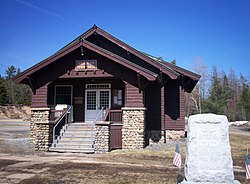
Brighton is a town in Rochester, NYMonroe County, New York, United States. The population was 37,137 at the 2020 census.

Perrine's Bridge is the second oldest covered bridge in the State of New York, after the Hyde Hall Bridge in East Springfield. Once located in the hamlet called Perrines Bridge between 1850 and 1861. It is located in the modern day town of Esopus-Rosendale, New York just a few hundred feet to the east of Interstate 87 crossing of the Wallkill River in Ulster County, New York. Originally built to aid in the movement of trade between the towns of Rifton and Rosendale, the bridge is about 90 miles north of New York city between mile markers 81 and 82 on the New York State Thruway. In May 1834 the State of New York authorized and provided money ($700) to Ulster county, NY, to build the bridge. In 1835, the bridge was built by Benjamin Wood, the one-lane wooden covered bridge has been closed to vehicular traffic since 1930. The Bridge derives its name from James W. Perrine, a descendant of Daniel Perrin "The Huguenot", who was a tavern keeper that opened an inn on the east side of that future bridge in 1820. Perrine's son was hired each winter as the "snower". He would spread snow the length of the structure so horse-drawn sleighs could cross.

List of the National Register of Historic Places listings in Franklin County, New York

The Beverley Road station is a local station on the BMT Brighton Line of the New York City Subway. It is located over a private right-of-way at Beverly Road between Marlborough Road/East 15th Street and East 16th Street in the neighborhood of Flatbush, Brooklyn. The station is served by the Q train at all times.

The Brighton Dome is an arts venue in Brighton, England, that contains the Concert Hall, the Corn Exchange and the Studio Theatre. All three venues are linked to the rest of the Royal Pavilion Estate by a tunnel to the Royal Pavilion in Pavilion Gardens and through shared corridors to Brighton Museum. The Brighton Dome is a Grade I listed building.

St Peter's Church is a church in Brighton in the English city of Brighton and Hove. It is near the centre of the city, on an island between two major roads, the A23 London Road and A270 Lewes Road. Built from 1824–28 to a design by Sir Charles Barry, it is arguably the finest example of the pre-Victorian Gothic Revival style. It is a Grade II* listed building. It was the parish church of Brighton from 1873 to 2007 and is sometimes unofficially referred to as "Brighton's cathedral".
Brighton and Hove has numerous notable pipe organs, from the small early 19th-century organs to the large 20th-century instruments in the large churches.

The Sterling Hill Mine, now known as the Sterling Hill Mining Museum, is a former zinc mine in Ogdensburg, Sussex County, New Jersey, United States. It was the last working underground mine in New Jersey when it closed in 1986, and it became a museum in 1989. Along with the nearby Franklin Mine, it is known for its variety of minerals, especially the fluorescent varieties. It was added to the National Register of Historic Places in 1991.
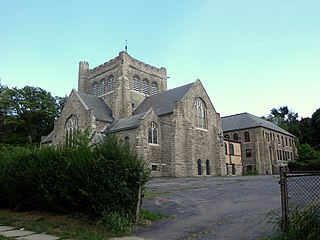
Christ Church New Brighton (Episcopal) is a historic Episcopal church complex at 76 Franklin Avenue in New Brighton, Staten Island, New York. The complex consists of a Late Victorian Gothic church (1904) and parish hall, connected to the church by an enclosed cloister, and a Tudor-style rectory (built 1879 and remodeled in 1909).

The Sacandaga Railroad Station is a historic train station located at 136 McKinley Avenue in the town of Northampton in Fulton County, New York. It was built in 1920 to serve Sacandaga Park and is a one-story, rectangular hipped roof wood-frame building, 125 feet by 30 feet, on a concrete slab foundation. It features exposed rafter ends, small louvered dormers, and broad eaves in the Shingle Style. In the 1950s it was converted for use as a stable. It is a rare surviving, non-residential building remaining from the heyday of Sacandaga Park as a resort established and served by the Fonda, Johnstown, and Gloversville Railroad.

The Golden Rod Grange No. 114 is a historic Grange hall on New Hampshire Route 32 in Swanzey, New Hampshire, United States. Built in 1916, it continues to occupy a significant place in the community as a meeting and function space. The little-altered building was listed on the National Register of Historic Places in 1994. It is now owned by the town and maintained by the Swanzey Preservation Society.
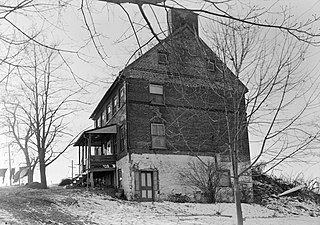
The Willis House is an historic, American home that is located in Manchester Township, York County, Pennsylvania.
This is a timeline and chronology of the history of Brooklyn, New York. Brooklyn is the most populous of New York City's boroughs, and was settled in 1646.

The Keniston Bridge is a historic covered bridge in Andover, New Hampshire, carrying Bridge Street over the Blackwater River. Built in 1882, it is of Town through truss construction, and is one of the few surviving 19th-century covered bridges in the state. It is also one of the only ones whose sides are not fully sheathed, exposing the trusses. The bridge was listed on the National Register of Historic Places in 1989.

Richmond Town Hall is the town hall of Richmond, New Hampshire, United States. Built in 1780, and originally used for both civic and religious purposes, it is one of the oldest meeting houses in the state. The building was listed on the National Register of Historic Places in 1979.

Hove Town Hall is the headquarters of Brighton and Hove City Council. The current building was constructed in 1970 in the Brutalist style by John Wells-Thorpe, to replace the original 1882 Hall which was damaged by fire in 1966.
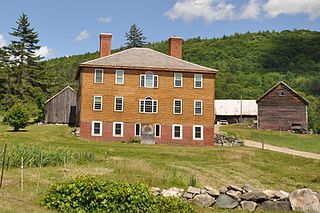
The Jeffrey House is a historic house on North Street in Chester, Vermont. Built in 1797, it is one of Vermont's small number of surviving Georgian style houses. It was built by the son of one of the area's early settlers, and originally served as a tavern. It was listed on the National Register of Historic Places in 1974.

The Willis House is a historic residence in Encampment, Wyoming, United States, that is listed on the National Register of Historic Places.
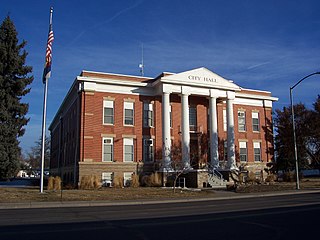
The Adams County Courthouse in Brighton, Colorado, located at 22 S 4th Ave., was built in 1906, and housed the judicial functions of Adams County until the 1970s when the legislation moved out and the building became the Brighton City Hall. It was listed on the National Register of Historic Places in 2006.
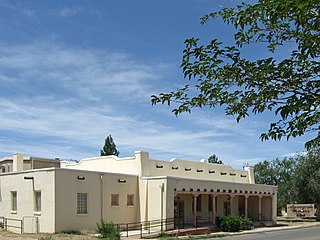
The Alamogordo Woman's Club is a women's club based in New Mexico. It operates under the auspices of the New Mexico Federation of Women's Clubs (NMFWC). The club was created to provide Alamogordo women a way to serve their community. Of note was the Alamogordo Woman's Club's providing books to school libraries.
